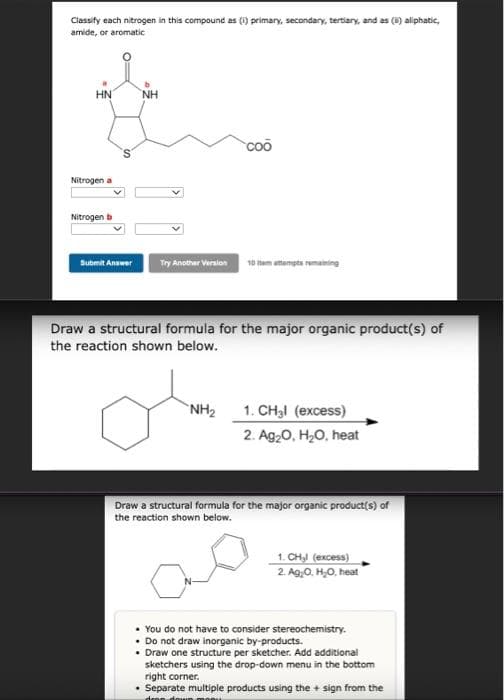Classify each nitrogen in this compound as (1) primary, secondary, tertiary, and as (i) aliphatic, amide, or aromatic HN Nitrogen a Nitrogen b Submit Answer NH coo Try Another Version 10 msing Draw a structural formula for the major organic product(s) of the reaction shown below. NH₂ 1. CH₂l (excess) 2. Ag₂O, H₂O, heat
Classify each nitrogen in this compound as (1) primary, secondary, tertiary, and as (i) aliphatic, amide, or aromatic HN Nitrogen a Nitrogen b Submit Answer NH coo Try Another Version 10 msing Draw a structural formula for the major organic product(s) of the reaction shown below. NH₂ 1. CH₂l (excess) 2. Ag₂O, H₂O, heat
Introduction to General, Organic and Biochemistry
11th Edition
ISBN:9781285869759
Author:Frederick A. Bettelheim, William H. Brown, Mary K. Campbell, Shawn O. Farrell, Omar Torres
Publisher:Frederick A. Bettelheim, William H. Brown, Mary K. Campbell, Shawn O. Farrell, Omar Torres
Chapter18: Carboxylic Acids
Section: Chapter Questions
Problem 18.54P
Related questions
Question
1

Transcribed Image Text:Classify each nitrogen in this compound as (1) primary, secondary, tertiary, and as (i) aliphatic,
amide, or aromatic
HN
Nitrogen a
Nitrogen b
Submit Answer
ΝΗ
Try Another Version
coo
oto
NH₂
10 item attempts remaining
Draw a structural formula for the major organic product(s) of
the reaction shown below.
1. CH₂l (excess)
2. Ag₂O, H₂O, heat
Draw a structural formula for the major organic product(s) of
the reaction shown below.
1. CH₂l (excess)
2. Ag₂O, H₂O, heat
• You do not have to consider stereochemistry.
. Do not draw inorganic by-products.
• Draw one structure per sketcher. Add additional
sketchers using the drop-down menu in the bottom
right corner.
• Separate multiple products using the + sign from the
drop down monu
Expert Solution
This question has been solved!
Explore an expertly crafted, step-by-step solution for a thorough understanding of key concepts.
Step by step
Solved in 6 steps with 4 images

Knowledge Booster
Learn more about
Need a deep-dive on the concept behind this application? Look no further. Learn more about this topic, chemistry and related others by exploring similar questions and additional content below.Recommended textbooks for you

Introduction to General, Organic and Biochemistry
Chemistry
ISBN:
9781285869759
Author:
Frederick A. Bettelheim, William H. Brown, Mary K. Campbell, Shawn O. Farrell, Omar Torres
Publisher:
Cengage Learning

Organic Chemistry
Chemistry
ISBN:
9781305580350
Author:
William H. Brown, Brent L. Iverson, Eric Anslyn, Christopher S. Foote
Publisher:
Cengage Learning


Introduction to General, Organic and Biochemistry
Chemistry
ISBN:
9781285869759
Author:
Frederick A. Bettelheim, William H. Brown, Mary K. Campbell, Shawn O. Farrell, Omar Torres
Publisher:
Cengage Learning

Organic Chemistry
Chemistry
ISBN:
9781305580350
Author:
William H. Brown, Brent L. Iverson, Eric Anslyn, Christopher S. Foote
Publisher:
Cengage Learning


Chemistry & Chemical Reactivity
Chemistry
ISBN:
9781337399074
Author:
John C. Kotz, Paul M. Treichel, John Townsend, David Treichel
Publisher:
Cengage Learning

Chemistry & Chemical Reactivity
Chemistry
ISBN:
9781133949640
Author:
John C. Kotz, Paul M. Treichel, John Townsend, David Treichel
Publisher:
Cengage Learning